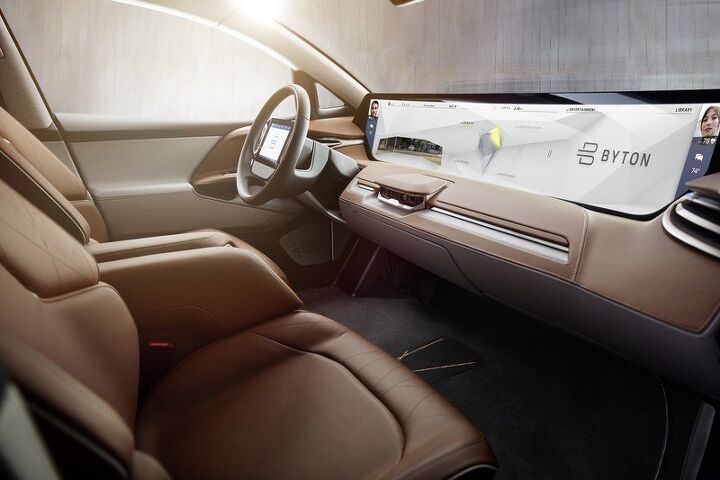Chinese Startup Byton Teases Electric 'SIV' Ahead of CES Debut

Even though automotive trade shows are becoming more tech-focused, its still a difficult environment for a fledgling carmaker to break into. That’s one reason the Consumer Electronics Show, now just called “CES,” has hosted so many Chinese startups these last few years. One of the newest is the e-car manufacturer Byton, formerly known as Future Mobility.
While Byton sounds more like the name of a vehicle than a brand — especially since it was, two months earlier — it’s infinitely better than mashing two of the auto industry’s most-popular buzzwords together and pretending it means something. The company was also wise to get away from any moniker that might allow the public to confuse it with Faraday Future.
However, adopting the name of its singular model means Byton had to come up with something new for the vehicle scheduled to make its world debut at CES next week. Now dubbed the SIV (smart intuitive vehicle), the Chinese-brand is promising a “next generation smart device” that is “uniquely built for the coming era of truly shared, smart mobility and autonomous driving.”
It certainly sounds like Byton is prepared to deliver some future mobility, but we’ve been burned before by tech-heavy cars arriving at CES. What does all of that marketing jargon mean?
For starters, the company promises the SIV will have a curved touchscreen spanning the entire length of the dashboard, with a secondary screen housed inside the steering wheel. That seems like overkill, but it would set it apart from other vehicles and allow passengers to watch Ben-Hur in its original ludicrously wide-aspect ratio of 2:76:1. However, other applications that would necessitate such a broad screen are difficult to imagine.
This is doubly true since drivers won’t actually need to handle the touchscreen. According to Byton, the SIV will come equipped with an array of interior sensors that allow drivers to use hand gestures to control the vehicle. While we’d prefer to reserve a few for expressing our feelings to other drivers, it might be interesting to toss out a pinky to indicate a left turn.
Other showoff tech goodies include a cloud platform that connects occupants’ smartphone apps and data. Byton also stated that the car uses facial recognition to allow for “intuitive access.” Although, as this is all pre-production, we may never see any of the technology. Hell, we may never even see the car.
Powering the SIV are a pair of electric motors: a 201-horsepower unit in the front and a 268-hp e-mill at the rear. The standard model is said to be equipped with a 71-kWh battery, but Byton claims a 95-kWh unit should be available as an option. The alleged range for the 71-kWh power-pack is 200 miles and the larger unit is supposedly good for an additional 110 miles.
Further details will be announced next week, when the Byton SIV debuts at CES 2018 on January 7th. Production is said to begin in China next year, though the firm fully intends to bring it Europe and the United States in 2020.
[Images: Byton]

A staunch consumer advocate tracking industry trends and regulation. Before joining TTAC, Matt spent a decade working for marketing and research firms based in NYC. Clients included several of the world’s largest automakers, global tire brands, and aftermarket part suppliers. Dissatisfied with the corporate world and resentful of having to wear suits everyday, he pivoted to writing about cars. Since then, that man has become an ardent supporter of the right-to-repair movement, been interviewed on the auto industry by national radio broadcasts, driven more rental cars than anyone ever should, participated in amateur rallying events, and received the requisite minimum training as sanctioned by the SCCA. Handy with a wrench, Matt grew up surrounded by Detroit auto workers and managed to get a pizza delivery job before he was legally eligible. He later found himself driving box trucks through Manhattan, guaranteeing future sympathy for actual truckers. He continues to conduct research pertaining to the automotive sector as an independent contractor and has since moved back to his native Michigan, closer to where the cars are born. A contrarian, Matt claims to prefer understeer — stating that front and all-wheel drive vehicles cater best to his driving style.
More by Matt Posky
Latest Car Reviews
Read moreLatest Product Reviews
Read moreRecent Comments
- V8fairy Not scared, but I would be reluctant to put my trust in it. The technology is just not quite there yet
- V8fairy Headlights that switch on/off with the ignition - similar to the requirement that Sweden has- lights must run any time the car is on.Definitely knobs and buttons, touchscreens should only be for navigation and phone mirroring and configuration of non essential items like stereo balance/ fade etc>Bagpipes for following too close.A following distance warning system - I'd be happy to see made mandatory. And bagpipes would be a good choice for this, so hard to put up with!ABS probably should be a mandatory requirementI personally would like to have blind spot monitoring, although should absolutely NOT be mandatory. Is there a blind spot monitoring kit that could be rerofitted to a 1980 Cadillac?
- IBx1 A manual transmission
- Bd2 All these inane posts (often referencing Hyundai, Kia) the past week are by "Anal" who has been using my handle, so just ignore them...
- 3-On-The-Tree I was disappointed that when I bought my 2002 Suzuki GSX1300R that the Europeans put a mandatory speed limiter on it from 197mph down to 186mph for the 2002 year U.S models.






































Comments
Join the conversation
"...truly shared, smart mobility and autonomous driving" No, maybe, and no. But it has a display in front of the driver, so it beats the Model 3 in that regard.
Anyone else think of Simian Immunodeficiency Virus?